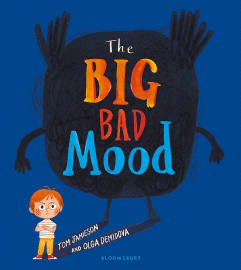The Big Bad Mood
Tom Jamieson
Olga Demidova
Bloomsbury, 2017
32pp., pbk., RRP $A14.99
9781408839201
George is having a very bad day – an I can’t, I won’t, I don’t kind of day as he grumbles and shouts and stomps. His mum tells him there is a big bad mood around him but George can’t see it and when he goes searching for it with no luck he gets even crankier. Then suddenly, The Big Bad Mood is standing right in front of him! Rough and smelly, it takes George by the hand and off they go to create mischief and mayhem.
At first it is fun but eventually…
Young children, and those around them, are no strangers to temper tantrums born of frustration as they push the boundaries of independence, but sometimes the stars are just not aligned and we wake up on the wrong side of the bed. But right from the get-go we learn that expressing our displeasure through shouting and stomping is not acceptable and so there can be an expectation that we should be happy and cheerful all the time, never giving into whatever is making us feel less so. Yet there can be no rainbows without rain and our lives are full of the ups and downs that give us light and shade so this is a wonderful kickstart to a discussion with little ones about whether it is ever OK to be angry and moody, and if so, how to deal with it.
As George goes about his day with The Big Bad Mood, he slowly begins to realise the impact his mood and behaviour are having on those around him and his attitude starts to change and then his actions follow suit. Little ones need to understand that being cranky is part of everyday life and it’s not a sin or a personality defect but it’s how they deal with the anger and frustration that shapes who they are, not just in the moment but long term as the responses we have become ingrained habits. Is the glass half-full or half-empty?
Often young people don’t have the vocabulary and the language skills to be able to articulate their frustration and that leads to even more tension but by having Olga Demidova’s illustrations that make the invisible visible they realise that bad moods are real, can be tangible and can be dealt with. Equally important is acknowledging the feelings of those who have been affected by their attitude and actions and the power of saying sorry and trying to do better. Even though the target audience of this book are still too young to be able to step back and look at what is causing their mood objectively, nevertheless the patterns of their behaviour are being laid down so discussions about why they get cross and what they can do about it, as George did, are vital.
A perfect addition to your mindfulness collection!

